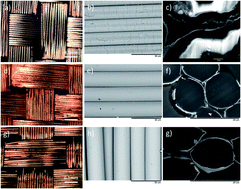Enhancing the capacitive performance of a textile-based CNT supercapacitor
Abstract
A metal layer, used as a current collector layer for a textile-based supercapacitor (SC), was prepared on polyethylene terephthalate (PET) fabrics using wet chemical methods. By integrating this additional current collector layer into the SC structure, the carbon-nanotube (CNT)-based SC showed an improved capacitive performance. The specific capacitances of the CNT/Cu/PET SC and CNT/Au/PET SC were 4.312 × 10−3 F cm−2 and 3.683 × 10−3 F cm−2 respectively, about 60 times larger than that obtained from the CNT/PET SC without the metal collector layer. On the other hand, the energy densities of these CNT-based SCs with metal layers were found to be ∼50 fold increased as compared to the CNT/PET SC. Similarly, the power densities of these two SCs with current collector layers were two orders of magnitude larger than that of CNT/PET SC. High flexibility was also demonstrated in these two metal-layered SCs. For the durability measurement, the CNT/Au/PET SC showed a stable performance, with its specific capacitance maintained at about 89% of its initial value after 2500 charge–discharge cycles. However, the CNT/Cu/PET SC only showed a relatively short-term stability, as its specific capacitance dropped to 12% of its initial value after 2500 charge–discharge cycles. In order to further improve its capacitive performance, polyaniline (PANI) was deposited on the CNT/Au/PET SC surface using a cyclic voltammetric deposition method. A specific capacitance of 0.103 F cm−2, about 30 times larger than that of the CNT/Au/PET SC, was obtained in the PANI/CNT/Au/PET SC which also showed good flexibility as well as high stability performance, with only 11% drop after 2500 charge–discharge cycles. On the basis of our results, we believe that by integrating a thin current collector layer into the textile-based CNT SC, its specific capacitance is enhanced while its flexibility and durability can be maintained. This method allows us to make any non-conducting fabric into a SC and turn it into a portable and wearable energy storage device.


 Please wait while we load your content...
Please wait while we load your content...